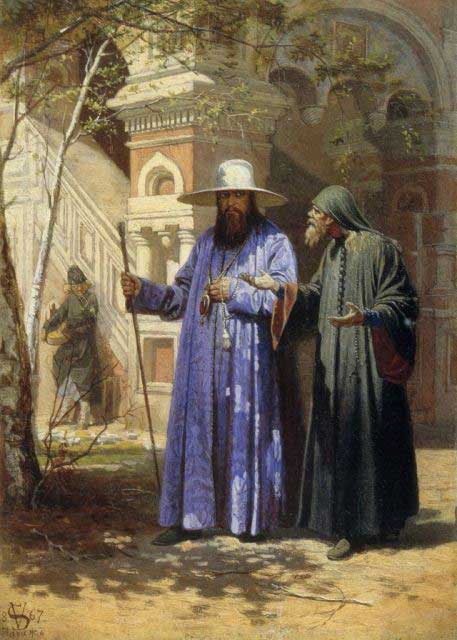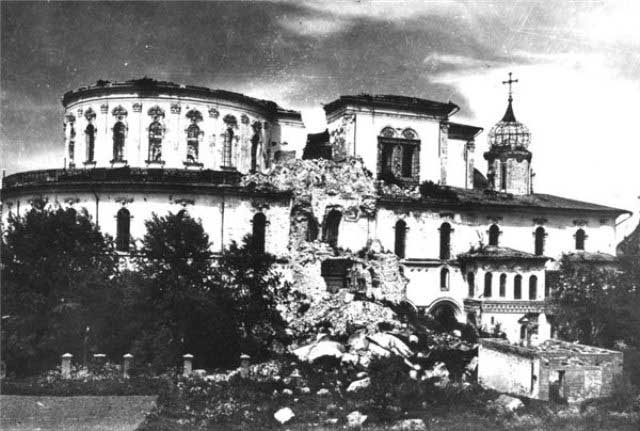History of Istra
16th Century
Origins
Since the 16th century there have been villages situated in the area now occupied by the city of Istra. Once such village was known as Safatovo until a church was built here in 1636 in honour of the Resurrection (Voskresenie in Russian) of Christ. Subsequently the village became known as Voskresenskoe.
17th Century
New Jerusalem Monastery
 In 1656 Patriarch Nikon bought the village of Voskresenskoe and the surrounding lands and established here the New Jerusalem Monastery to serve as the regional residence of the patriarch. Nikon intended to create a Russian version of the Holy Land here, hence its name. Nikon chose a hill surrounded by the River Istra on three sides as the location of his monastery. The River Istra represented the River Jordan and he named the hill Gora Sion (Russian for Mount Zion) and the summit of the hill Yeleon (Russian for the Mount of Olives). The Resurrection Cathedral was built using the Church of the Holy Sepulchre in Jerusalem as an example. The garden around the monastery was named Gefsimansky Sad (Garden of Gethsemane). Upon Patriarch Nikon's fall from grace in 1658, he retired to the monastery until he was later exiled to the Ferapontov Monastery near Vologda.
In 1656 Patriarch Nikon bought the village of Voskresenskoe and the surrounding lands and established here the New Jerusalem Monastery to serve as the regional residence of the patriarch. Nikon intended to create a Russian version of the Holy Land here, hence its name. Nikon chose a hill surrounded by the River Istra on three sides as the location of his monastery. The River Istra represented the River Jordan and he named the hill Gora Sion (Russian for Mount Zion) and the summit of the hill Yeleon (Russian for the Mount of Olives). The Resurrection Cathedral was built using the Church of the Holy Sepulchre in Jerusalem as an example. The garden around the monastery was named Gefsimansky Sad (Garden of Gethsemane). Upon Patriarch Nikon's fall from grace in 1658, he retired to the monastery until he was later exiled to the Ferapontov Monastery near Vologda.
18th Century
Administrative Reform
As part of the administrative reforms of the Russian Empire, in 1781 Voskresenskoe became a city under the new name of Voskresensk and the administrative centre of the newly established Voskresensk District. However the Voskresensk District was liquidated in 1796 and Voskresensk became a 'zashtatny' city, namely a city which is not a district centre.
20th Century
Soviet Era
In 1930 the city of Voskresensk was renamed Istra after the river. This was partly to get rid of a name with religious connotations but also to end the confusion caused by there being another Voskresensk in the south-east of the Moscow Region. The New Jerusalem monastery was closed down in 1919. In 1921 the former monastery was reorganised as a regional museum. The museum became known as the Regional Museum of the Moscow Region and exhibited relics and items from the former monastery, paintings and materials unearthed in archaeological digs, as well as the buildings of the former monastery themselves.
Second World War
 Istra fell to the Nazis on 26 November 1941, but was liberated shortly afterwards on the 10 December 1941. The occupation may have been brief but the Nazis were nevertheless able to inflict great destruction on the city and on the New Jerusalem Monastery in particular. The monastery was ransacked and any exhibition of the museum that was not evacuated or hidden in time was looted or lost, the bell tower was blown up and completely destroyed, several towers and parts of the great walls were damaged and the Resurrection Cathedral was so heavily damaged that no dome survived. The wanton destruction was so great that at the Nuremberg Trials it was referenced as just one of the examples of the barbarism inflicted on the Soviet Union by the Nazis. After the war, expert restorers set out on the herculean task of restoring the monastery, which continued up to the 1980s. Even today the monastery has not been completely restored and further restoration work continues.
Istra fell to the Nazis on 26 November 1941, but was liberated shortly afterwards on the 10 December 1941. The occupation may have been brief but the Nazis were nevertheless able to inflict great destruction on the city and on the New Jerusalem Monastery in particular. The monastery was ransacked and any exhibition of the museum that was not evacuated or hidden in time was looted or lost, the bell tower was blown up and completely destroyed, several towers and parts of the great walls were damaged and the Resurrection Cathedral was so heavily damaged that no dome survived. The wanton destruction was so great that at the Nuremberg Trials it was referenced as just one of the examples of the barbarism inflicted on the Soviet Union by the Nazis. After the war, expert restorers set out on the herculean task of restoring the monastery, which continued up to the 1980s. Even today the monastery has not been completely restored and further restoration work continues.

 History
History